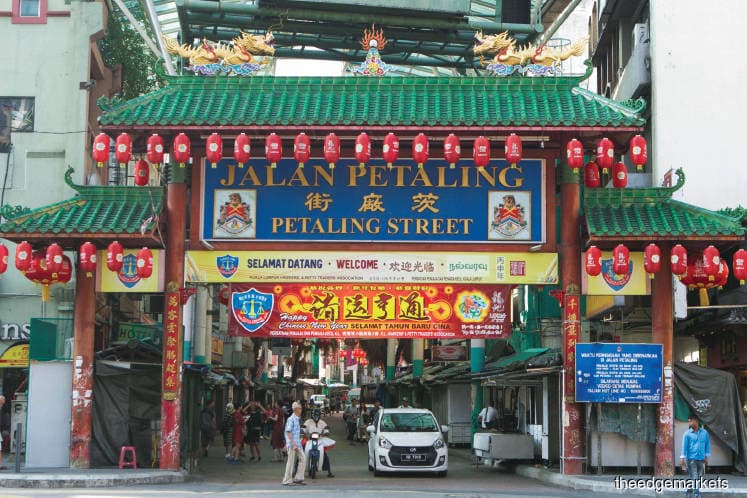
This article first appeared in City & Country, The Edge Malaysia Weekly on April 22, 2019 - April 28, 2019
Petaling Street, which runs for about 1km from Bulatan Merdeka to Jalan Yap Ah Loy — was one of the earliest roads to be built in Kuala Lumpur. In the late 1800s, it led to the tin mines in the Petaling district. It has come a long way, surviving various disasters including massive floods, conflict within the Chinese community in the 1870s, British colonisation and World War 2.
The best known stretch — fondly called Chee Cheong Kai, which means Tapioca Mill Street in Cantonese — is where the market is located. The name dates back to the time of Yap Ah Loy, who was said to own a tapioca factory there.
Along the street are some famous food stalls and restaurants, among them, Restoran Yook Woo Hin, which was shuttered in 2012. Back then, one could get piping hot dim sum served on carts at the restaurant, which I often frequented for breakfast during my school days in the 1990s. Yook Woo means jade teapot while Hin translates as house, so the name means House of Jade Teapot. Established in 1928, it was a landmark in the area until it closed its doors for good. However, the yellow, green and red signage can still be seen till today.
Some food stalls, however, are still going strong, including Sze Ngan Chye roast duck and Madam Tang Muah Chee next to it. Many of us would remember the air mata kucing drink stall nearby.
Back then, the huge canopy over the two-way street had yet to be erected, and neither were the arches at the two ends. It was easily accessible by cars.
Over the years, Petaling Street has seen tremendous transformation. Many of the shops are no more, while the stalls are run in large part by foreigners.
Connectivity has improved over the years. While in the early days, one had to get there by car or the pink lady — as mini buses were known as — now, visitors can take the monorail or LRT. The street is also easily accessible from the Pudu Sentral Bus Terminal and Pasar Seni MRT Station.
Looking back at its history, Zerin Properties founder and CEO Previndran Singhe considers the 1960s to 1980s to be the golden age of Petaling Street, when it had an eclectic mix of shops and thriving commercial activities.
The street slowly began to lose its heritage and cultural identity with rapid urbanisation and the influx of foreigners, he observes.
He says the government, aware that the street was losing its attractiveness, undertook a major facelift of the area in 2003 at a cost of RM11 million. The two large Chinese arches to welcome visitors were placed at either end and the street was transformed into a pedestrian shopping haven.
It is regarded as a heritage site, he adds.
The new Petaling Street, or new Chinatown, is bustling and has been transformed into an alternative shoppers’ paradise, Previndran notes.
The transformation is largely due to the wholesale trade of various imitation goods such as clothes, shoes, watches and bags, unlike in the past, when business mostly revolved around traditional local goods.
The businesses currently comprise wholesalers, massage and spa shops, and stalls selling DVDs/CDs, imitation accessories and apparel. There are some budget hotels, cafés and bars along the street.
“The shops are generally owned and operated by local Chinese although in recent years, businesses operated by foreigners, such Bangladeshis and Nepalese, have overtaken the locals,” Previndran notes. It is estimated that at least 60% of the traders in Chinatown are foreigners.
Previndran says transaction prices for prewar shoplots have increased gradually, from RM5.3 million a unit in 2013 to RM5.6 million last year.
“Current asking prices range from RM1,000 to RM1,600 psf, depending on the size, location and condition of the building,” he notes. “The rental market has remained stable over the years. Current asking rentals for shoplots is RM3 to RM8.50 psf for the built-up area. Ground floor units usually fetch higher rental psf.”
He believes Petaling Street will continue to be a popular tourist and shopping spot, in line with the government’s efforts to preserve and promote the area as a historical and culturally rich enclave.
Previndran also suggests that traders and Kuala Lumpur City Hall take a cue from George Town in maintaining and managing heritage buildings, which could hopefully lead to the designation of another Unesco World Heritage site in Malaysia.
“The prime and strategic location with excellent connectivity to public transport, preservation efforts by DBKL and Badan Warisan Malaysia, as well as the multiplier effect from The River of Life project make the future prospects of Petaling Street highly promising and it will contribute positively to the local tourism sector, real estate market and economic growth,” he says.
Save by subscribing to us for your print and/or digital copy.
P/S: The Edge is also available on Apple's AppStore and Androids' Google Play.